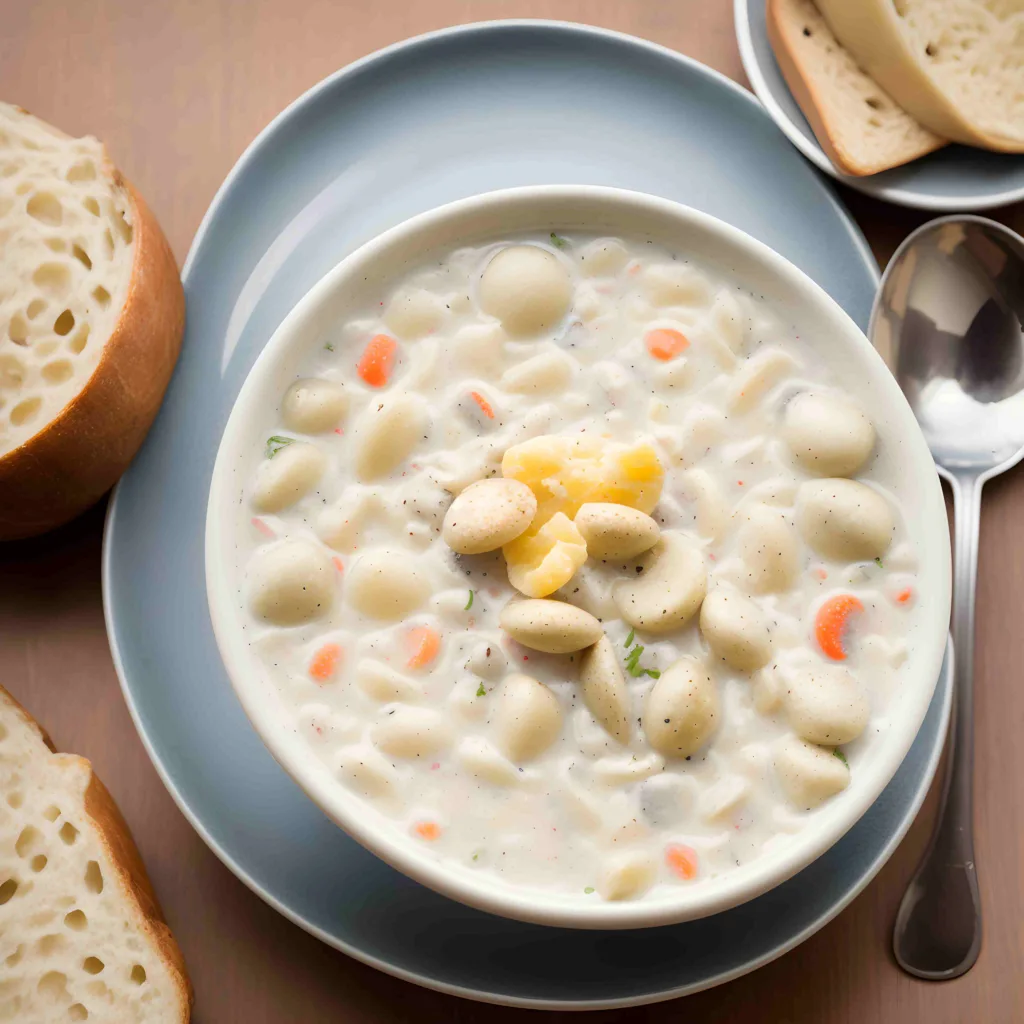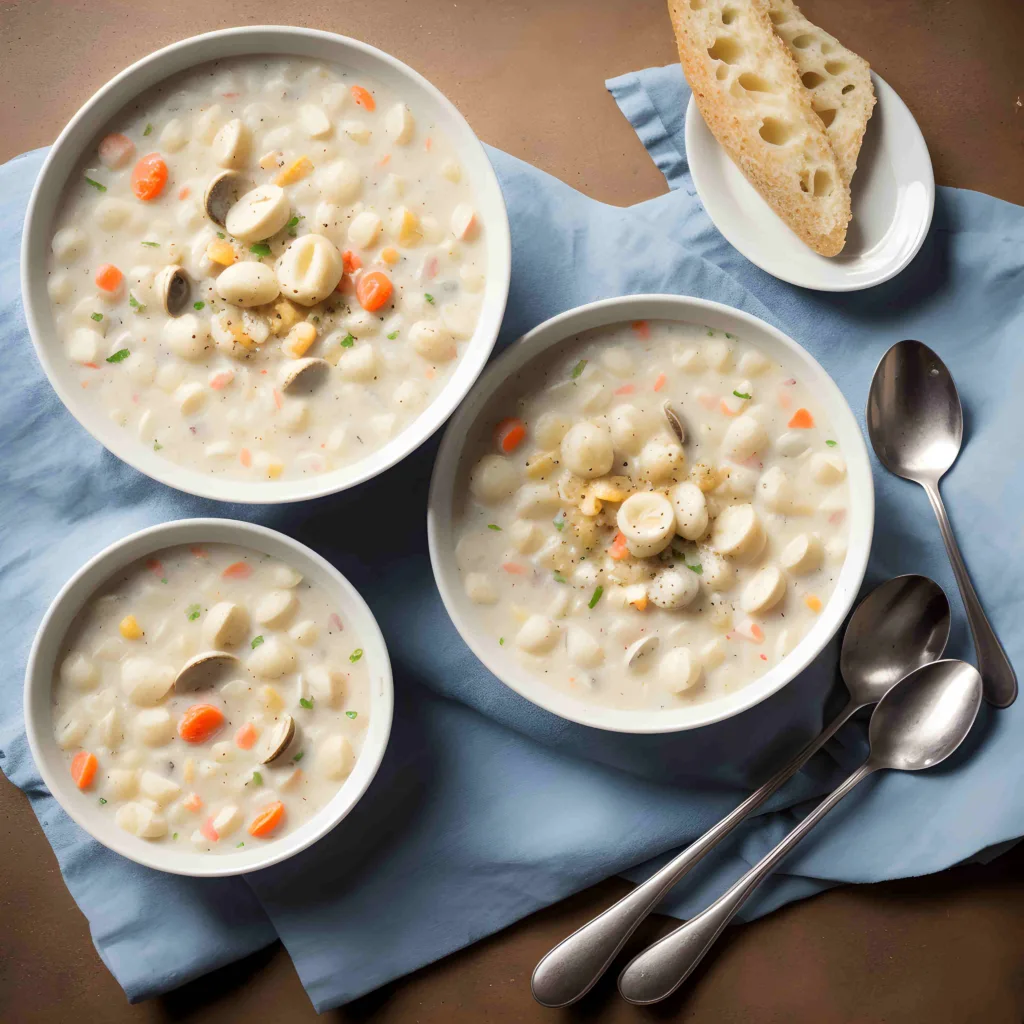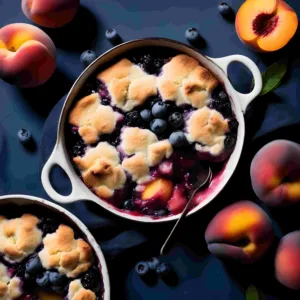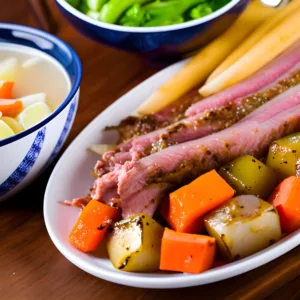This post may contain affiliate links which means I may receive a commission for purchases made through links.

Table of Contents
Audio Stream for this article
Introduction
New England clam chowder, a classic and comforting dish, holds a special place in the hearts of food lovers across the United States. Originating from the Northeastern region, particularly in coastal areas, this creamy soup has a rich history and is deeply intertwined with the maritime traditions of New England.
Dating back to the early 18th century, New England clam chowder was born out of the abundance of clams found in the coastal waters. It quickly became a favorite among fishermen and seafarers, providing warmth and sustenance during long and arduous journeys at sea. Over the years, this chowder has evolved into a culinary symbol of the region.
One of the defining characteristics of New England clam chowder is its indulgent cream-based broth. The creamy texture is achieved by combining milk or heavy cream with a flavorful clam broth. This combination creates a velvety base that perfectly complements the tender chunks of clams, resulting in a luscious and satisfying dish.
The star ingredient of this chowder is, of course, the clams. Freshly harvested clams, such as Quahogs or Cherrystones, are preferred for their briny flavor and delicate texture. The clams are usually steamed or boiled until they open, releasing their juices, which become an essential part of the broth. The clams are then removed from their shells and added back into the chowder, adding a delightful seafood essence to every spoonful.
In addition to clams and the creamy base, New England clam chowder typically includes aromatic vegetables like onions, celery, and garlic. These ingredients impart a savory depth to the chowder, while herbs like thyme or bay leaves enhance the overall flavor profile. The chowder can be further customized with diced potatoes for added heartiness or bacon for a smoky twist.
New England clam chowder’s popularity has transcended regional boundaries, earning a place on menus around the country and even internationally. Its creamy, comforting nature and the combination of flavors that highlight the ocean’s bounty have made it a beloved dish for seafood enthusiasts and comfort food aficionados alike.
Understanding New England Clam Chowder
New England clam chowder is renowned for its distinctive characteristics and flavors that set it apart from other chowder varieties. Let’s explore what makes this dish so special.
Characteristics and Distinguishing Features
New England clam chowder is known for its creamy and velvety texture, which is achieved through the combination of a rich dairy base and the natural juices released by the clams. The creamy broth provides a smooth and luxurious mouthfeel, enveloping every spoonful with comforting richness.
One of the defining features of New England clam chowder is the generous inclusion of hearty chunks of clams. These clams bring a delightful brininess to the chowder, infusing it with their distinct seafood flavor. The clams are tender and succulent, providing a satisfying contrast to the creamy base.
Creamy base and signature flavors
The creamy base of New England clam chowder is a key element that makes it so indulgent and comforting. Traditionally, a combination of milk or cream and clam broth is used to create the base. The dairy imparts a smooth and luscious consistency, while the clam broth infuses the chowder with a delicious seafood essence.
The flavors of New England clam chowder are well-balanced, with the natural sweetness of the clams complemented by savory notes from ingredients like onions, celery, and garlic. These aromatic vegetables are typically sautéed before being incorporated into the chowder, enhancing its depth and complexity. The addition of herbs such as thyme or bay leaves further enhances the overall flavor profile, adding a subtle earthiness to the dish.
Regional variations and preferences
While New England clam chowder has a well-defined identity, there can be slight variations in preparation and ingredients based on regional preferences. Some variations may include the addition of diced potatoes, which not only contribute to the chowder’s heartiness but also provide a pleasant textural element. Bacon is another popular addition, lending a smoky undertone that complements the flavors of the clams.
Regional preferences can also influence the consistency of the chowder. In some areas, New England clam chowder tends to be thick and creamy, while others prefer a slightly thinner and soup-like consistency. These variations in texture allow for personalization and adaptability to individual taste preferences.
Whether you enjoy a classic rendition or a regional variation, New England clam chowder continues to captivate palates with its harmonious blend of creamy base, tender clams, and balanced flavors. Now that we understand the characteristics and flavors that define this beloved dish, let’s dive into the process of creating your own homemade New England clam chowder.
Gathering the Ingredients
Before embarking on the journey of making New England clam chowder, it’s essential to gather all the necessary ingredients and kitchen materials. Here’s what you’ll need:
Serving Size
The serving size for New England clam chowder can vary depending on whether it is served as an appetizer or a main course. This particular recipe serves 4-6 people. However, keep in mind that serving sizes can vary based on individual preferences and appetites. If you are serving it as a main course, you might want to consider doubling the recipe or adjusting the quantities according to the number of guests you’re serving
Ingredients
To ensure the best flavor and quality in your clam chowder, it’s crucial to use fresh, high-quality ingredients. Here’s a detailed list of the ingredients required:
– Fresh clams: Aim for approximately 2 pounds (900g) of fresh clams, such as Quahogs or Cherrystones.
– Onion: 1 medium-sized, finely chopped.
– Celery: 2 stalks, finely chopped.
– Garlic: 2 cloves, minced.
– Butter: 3 tablespoons.
– All-purpose flour: 3 tablespoons.
– Milk or heavy cream: 2 cups (480 ml).
– Clam broth: Approximately 1 cup (240 ml), reserved from steaming the clams.
– Clam juice: 1 cup (240 ml), for added flavor (optional).
– Potatoes: 2 medium-sized, peeled and diced (optional).
– Bay leaves: 2 leaves.
– Fresh thyme: 1 teaspoon, chopped (or ½ teaspoon dried thyme).
– Salt: To taste.
– Black pepper: To taste.
– Fresh parsley: For garnish (optional).
Kitchen Materials:
To make the New England clam chowder, make sure you have the following kitchen materials:
– A large pot or Dutch oven for cooking the chowder.
– A steamer or a large pot with a steaming rack for steaming the clams.
– A slotted spoon or tongs for removing clams from their shells.
– A sharp knife for chopping the vegetables.
– A cutting board for preparing the ingredients.
– Measuring cups and spoons for accurate ingredient quantities.
– A whisk or a wooden spoon for stirring the chowder.
Using fresh clams and alternatives
Using fresh clams is highly recommended to achieve the authentic flavor and texture of New England clam chowder. Look for clams that are tightly closed, indicating their freshness. If fresh clams are not readily available, you can use canned clams as a suitable alternative. Make sure to drain and rinse the canned clams before adding them to the chowder. Additionally, you can also substitute clams for seafood like shrimp or scallops for a delightful variation.
Remember, the quality of ingredients plays a vital role in the final taste of your chowder. Opting for fresh and high-quality ingredients ensures a truly exceptional New England clam chowder experience. With all the ingredients and kitchen materials at your disposal, you’re ready to proceed to the next steps of the recipe.
Preparing New England clam chowder
To ensure that your New England clam chowder showcases the natural flavors of fresh clams, it’s important to properly clean and prepare them. Here’s a step-by-step guide to help you through the process:
How to Clean the clams
Start by examining the clams. Discard any clams with cracked shells or ones that are already open and do not close when lightly tapped.
Rinse the clams under cold running water to remove any debris or sand clinging to the shells. Gently scrub the shells using a brush or your fingers. For stubborn dirt or sand, you can soak the clams in a bowl of cold water with a tablespoon of cornmeal for about 30 minutes. This encourages the clams to expel any remaining grit.
After soaking, rinse the clams once more to ensure they are clean. Set them aside while you prepare for steaming or boiling.
How to Steam or boil the clams
To steam the clams, place them in a large pot with a steamer basket or rack. Add about an inch of water to the pot. Cover the pot with a lid and bring the water to a boil over medium-high heat. Steam the clams for 5 to 7 minutes or until the shells open. Be careful not to overcook them, as they can become tough.
If you prefer boiling, add the clams to a pot of boiling water. Cook for 3 to 5 minutes or until the clams open. As the clams cook, they will release flavorful juices. This liquid, known as clam broth, is an essential component of the chowder.
Removing the clams and reserving the broth
Once the clams have opened, carefully remove them from the pot using tongs or a slotted spoon. Place them in a bowl. Discard any clams that did not open during cooking, as they may be unfit for consumption.
Allow the clams to cool slightly before handling. Once they are cool enough to touch, remove the clams from their shells. Discard the shells and set aside the clam meat. Strain the cooking liquid from the pot through a fine-mesh sieve or cheesecloth to remove any impurities. This strained liquid is the precious clam broth, which will enhance the flavor of your chowder.
Measure out approximately 1 cup (240 ml) of the reserved clam broth for use in the chowder. Any extra broth can be stored for future use or frozen for later. By following these steps, you’ll have perfectly cleaned and cooked clams, ready to be incorporated into your New England clam chowder. With the clams prepared, it’s time to move on to creating the creamy base and assembling the chowder.
Creating the Creamy Base
The creamy base is the heart of New England clam chowder, providing a velvety texture and a luxurious flavor. Here’s a step-by-step guide to help you create the rich and creamy chowder base:
Sautéing aromatic Vegetables
In a large pot or Dutch oven, melt 3 tablespoons of butter over medium heat. Add the finely chopped onion, celery, and minced garlic to the pot. Sauté the vegetables for about 5 minutes or until they become translucent and fragrant. This step is crucial as it helps develop the foundational flavors of the chowder.
Incorporating flour and butter
Sprinkle 3 tablespoons of all-purpose flour over the sautéed vegetables in the pot. Stir continuously for about 2 minutes, allowing the flour to cook and combine with the butter, creating a roux. The roux will act as a thickening agent for the chowder. Cooking the flour helps eliminate any raw taste and ensures a smooth, silky texture for your chowder base.
Adding the Liquid
Gradually pour in 2 cups (480 ml) of milk or heavy cream, stirring continuously to combine the roux with the liquid. This mixture will thicken as it heats. Adjust the heat to medium-low to prevent scorching or sticking, and continue stirring until the mixture reaches a gentle simmer.
At this point, incorporate the reserved clam broth, approximately 1 cup (240 ml), into the pot. The clam broth adds a depth of flavor that is essential to authentic New England clam chowder. For an extra burst of clam flavor, you can also add 1 cup (240 ml) of clam juice to the pot. This step is optional but highly recommended.
Seasoning and simmering
Add 2 bay leaves and 1 teaspoon of chopped fresh thyme (or ½ teaspoon dried thyme) to the pot. These herbs will infuse the chowder with subtle aromatic notes. Season the chowder base with salt and black pepper to taste. Start with a conservative amount of salt, as the clams and other ingredients will contribute their own natural salinity.
Stir the chowder base well to ensure the flavors are evenly distributed. Allow the chowder to simmer over low heat for approximately 15 to 20 minutes, stirring occasionally. This simmering process helps meld the flavors together and develop the desired consistency.
Thickening and adjusting the chowder
As the chowder simmers, it will naturally thicken. However, if you prefer a thicker consistency, you can create a slurry by mixing equal parts cornstarch and cold water. Stir the slurry into the chowder and continue simmering for a few more minutes until desired thickness is achieved. Taste and adjust the seasoning as needed, adding more salt and pepper if desired.
By following these steps, you’ll have a rich and creamy chowder base, infused with the flavors of sautéed vegetables, herbs, and the essence of the clams. The next step is to incorporate the clams and additional ingredients, bringing the chowder together in all its delightful glory.
Cooking and assembling the chowder
Now that the creamy base is ready, it’s time to incorporate the clams and additional ingredients, season the chowder to perfection, and explore some optional variations to enhance the flavor and texture. Here’s a detailed explanation of the process:
Adding clams
Gently add the reserved clam meat to the chowder base. Stir well to distribute the clams throughout the soup. If you prefer a heartier chowder, add diced potatoes to the pot. Simmer the chowder until the potatoes are tender, typically around 10 to 15 minutes. Remember to remove the bay leaves from the chowder before continuing.
Seasoning the chowder
Season the chowder with salt and black pepper to taste. Start with a conservative amount and adjust according to your preference. The flavors of the clams and other ingredients should guide your seasoning decisions. To enhance the aromatic notes, you can sprinkle some fresh thyme leaves or a pinch of dried thyme over the chowder. Stir well to incorporate the herbs and their flavors.
Taste the chowder and make any necessary adjustments to the seasoning. Keep in mind that flavors tend to develop further as the chowder simmers.
Optional ingredients and variations
Diced potatoes: If not already added, including diced potatoes can add a delightful texture and heartiness to the chowder. Simmer until the potatoes are tender but still hold their shape.
Bacon: For a smoky twist, consider frying and crumbling bacon before adding it to the chowder. The bacon adds a layer of complexity and savory flavor.
Corn: Adding kernels of fresh or frozen corn can bring a touch of sweetness and vibrant color to the chowder. Simmer the corn until it is cooked through.
Herbs and spices: Feel free to experiment with additional herbs or spices like parsley, dill, paprika, or Old Bay seasoning to customize the flavor profile of your chowder.
Simmering and Final Adjustments:
The simmering allows the flavors to meld and ensures that all the ingredients are thoroughly cooked and infused with one another. Taste the chowder one last time and make any final adjustments to the seasoning, adding salt, pepper, or herbs as desired.
The simmering time for New England clam chowder typically ranges from 10 to 15 minutes after all the ingredients have been incorporated. This duration allows the flavors to infuse, the clams to become tender, and any additional ingredients like potatoes to cook through.
During the simmering process, it’s important to occasionally stir the chowder to prevent it from sticking to the bottom of the pot and to ensure even heat distribution. Stirring also helps to incorporate any ingredients that may have settled, ensuring a consistent and well-balanced chowder.
With the clams, additional ingredients, and seasonings fully incorporated and the flavors melding beautifully, your New England clam chowder is now ready to be served. Ladle it into bowls, garnish with fresh parsley if desired, and savor the comforting and delicious flavors of this classic dish.
Serving suggestions
When it comes to serving New England clam chowder, there are various options to enhance the dining experience. Here are a few suggestions:
Garnishes: Sprinkle freshly chopped parsley over each bowl of chowder before serving. The vibrant green color adds a visually appealing touch, while the parsley’s freshness complements the flavors of the dish. Alternatively, you can garnish with a sprig of fresh thyme or a sprinkle of chopped chives.
Oyster Crackers: Traditionally, New England clam chowder is often served with oyster crackers on the side. These small, crisp crackers provide a pleasant crunch and can be added to the chowder or enjoyed separately. They can be a delightful accompaniment, adding texture and enhancing the overall experience.
Bread or Biscuits: Serve warm crusty bread or homemade biscuits alongside the chowder. These bread options are perfect for sopping up the creamy broth and adding an extra element of satisfaction to each bite.
Additional Seasoning: At the table, offer freshly ground black pepper or hot sauce for those who prefer a bit of extra heat or flavor kick. This allows each individual to customize their chowder according to their taste preferences.
Congratulations!
Congratulations! you have successfully learnt how to make traditionally homemade New England clam chowder. So, gather the ingredients, roll up your sleeves, and embark on the culinary adventure of making your own New England clam chowder. The rewarding experience and the incredible flavors await you. Enjoy the warmth, comfort, and satisfaction that this classic dish brings to your table.
Happy Eating!!!




